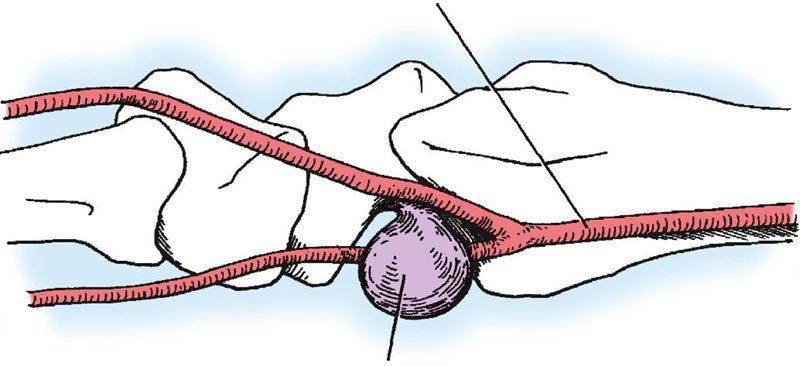
Wrist Ganglion
Ganglion cysts are the most common cause of a bump or mass about the wrist. They are 100% benign. Ganglion cysts are simply herniations of fluid that come from the underlying wrist joint. The herniation is caused by a weakness in the wrist’s capsule, the “balloon” of ligaments surrounding the joint. Laxity or damage to an area of the joint capsule allows the joint fluid that lubricates the wrist to herniate out into the surrounding areas, forming a ganglion cyst with a “stalk” leading back to the joint capsule. A one-way valve mechanism forms in the capsule at the base of the ganglion’s stalk and prevents the fluid from returning to the wrist, trapping it in the cyst. Because most ganglion cysts come from an underlying joint, ganglions may get bigger during periods of heavy activity and become smaller during periods of rest.
It’s important to understand that not every bump is a ganglion. However, Ganglions can be diagnosed fairly easily. Ganglions on the back of the wrist can be aspirated in the office. This involves numbing the overlying skin with lidocaine using a small needle, similar to the Novocaine used by dentists. A larger needle is then placed through the numbed skin to draw out the gelatinous fluid inside. This causes the ganglion to disappear or at least decrease in size, and in 1/3 of cases provides a permanent cure. Sometimes the Ganglion has separations or sub-compartments within it that make it difficult to fully aspirate. Consequently, Ganglions with multiple compartments have a lower rate of cure by aspiration.
Ganglions on the palmar surface of the wrist are not usually aspirated. This is because they are usually intertwined with the radial artery, and a large needle could injure the artery or the nearby median nerve. These ganglion cysts can either be left alone or removed surgically. Ganglions may also occur in the fingers, in unusual locations about the wrist, or over other joints.
Once a Ganglion is diagnosed, it does not have to be removed. Except in rare cases where the cyst presses directly on a nerve, it will not cause any damage. However, Ganglions can cause pain or tenderness, and many people want them removed because they often look unsightly.
Dorsal Wrist Ganglion Excision
Ganglion excision surgery is quick and highly effective. While the literature quotes a 5-10% rate of recurrence for ganglions on the back of the wrist and a 10-20% rate of recurrence for ganglions on the palmar surface of the wrist, as far as I know I’ve only had one recurrence out of the hundreds of Ganglions that I’ve removed. The key to preventing recurrence is to remove enough of the joint capsule (the balloon around the joint) to ensure that it can’t scar back to itself and so it remains partially open. This prevents the reformation of a one-way valve and creates a permanent “two-way valve”, which prevents recurrence of the ganglion.
Volar Ganglion Excision
Ganglions in children have a much higher recurrence rate following both aspiration and surgical removal. Strong consideration should be given to not surgically removing Ganglions in children until they’ve reached “skeletal maturity”, around the age of 16 years. However, the mass should still be evaluated by a hand surgeon to ensure that it is, in fact, a Ganglion and not another type of lesion.
Following Ganglion Cyst removal, typing and computer use is allowed immediately. There are no formal activity restrictions, but heavy activities should be avoided for 1-2 weeks to minimize pain and swelling. The wound should be kept clean and dry for 3 days. After 3 days the dressings can be removed and showering is allowed. After showering, blot the wound dry and place a Band-Aid over it. Don’t submerge the wound under water until the stitches are removed, which occurs at 2 weeks. Complications are uncommon from Ganglion Cyst removal, except for stiffness, which can occur if motion is not regained following surgery. To prevent stiffness, once the dressings are removed 3 days after surgery, the wrist should be stretched into flexion and extension. This is best done when the body temperature is raised, such as in a hot shower or after jogging, etc. A pulling is often felt during motion exercises; this is normal and nothing to worry about. If full wrist motion has not been regained by the time of the first postoperative visit 2 weeks after surgery, hand therapy will be prescribed.
The take home message is that, once a mass is diagnosed as a Ganglion cyst, it doesn’t have to be removed. If surgical excision is desired, this is an extremely effective outpatient procedure with a very low recurrence rate.

